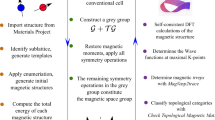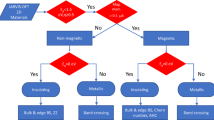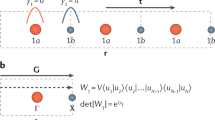Abstract
The discoveries of intrinsically magnetic topological materials, including semimetals with a large anomalous Hall effect and axion insulators1,2,3, have directed fundamental research in solid-state materials. Topological quantum chemistry4 has enabled the understanding of and the search for paramagnetic topological materials5,6. Using magnetic topological indices obtained from magnetic topological quantum chemistry (MTQC)7, here we perform a high-throughput search for magnetic topological materials based on first-principles calculations. We use as our starting point the Magnetic Materials Database on the Bilbao Crystallographic Server, which contains more than 549 magnetic compounds with magnetic structures deduced from neutron-scattering experiments, and identify 130 enforced semimetals (for which the band crossings are implied by symmetry eigenvalues), and topological insulators. For each compound, we perform complete electronic structure calculations, which include complete topological phase diagrams using different values of the Hubbard potential. Using a custom code to find the magnetic co-representations of all bands in all magnetic space groups, we generate data to be fed into the algorithm of MTQC to determine the topology of each magnetic material. Several of these materials display previously unknown topological phases, including symmetry-indicated magnetic semimetals, three-dimensional anomalous Hall insulators and higher-order magnetic semimetals. We analyse topological trends in the materials under varying interactions: 60 per cent of the 130 topological materials have topologies sensitive to interactions, and the others have stable topologies under varying interactions. We provide a materials database for future experimental studies and open-source code for diagnosing topologies of magnetic materials.
This is a preview of subscription content, access via your institution
Access options
Access Nature and 54 other Nature Portfolio journals
Get Nature+, our best-value online-access subscription
$29.99 / 30 days
cancel any time
Subscribe to this journal
Receive 51 print issues and online access
$199.00 per year
only $3.90 per issue
Buy this article
- Purchase on Springer Link
- Instant access to full article PDF
Prices may be subject to local taxes which are calculated during checkout


Similar content being viewed by others
Data availability
All data are available in the Supplementary Information and at https://www.topologicalquantumchemistry.fr/magnetic. The codes required to calculate the character table of magnetic materials are available at https://www.cryst.ehu.es/cryst/checktopologicalmagmat.
References
Wang, Q. et al. Large intrinsic anomalous Hall effect in half-metallic ferromagnet Co3Sn2S2 with magnetic Weyl fermions. Nat. Commun. 9, 1–8 (2018).
Liu, E. et al. Giant anomalous Hall effect in a ferromagnetic kagome-lattice semimetal. Nat. Phys. 14, 1125–1131 (2018).
Otrokov, M. M. et al. Prediction and observation of an antiferromagnetic topological insulator. Nature 576, 416–422 (2019).
Bradlyn, B. et al. Topological quantum chemistry. Nature 547, 298–305 (2017).
Vergniory, M. G. et al. A complete catalogue of high-quality topological materials. Nature 566, 480–485 (2019).
Zhang, T. et al. Catalogue of topological electronic materials. Nature 566, 475–479 (2019).
Elcoro, L. et al. Magnetic topological quantum chemistry. Preprint at https://arxiv.org/abs/2010.00598 (2020).
Kane, C. L. & Mele, E. J. Z 2 topological order and the quantum spin Hall effect. Phys. Rev. Lett. 95, 146802 (2005).
Bernevig, B. A. & Hughes, T. L. & Zhang, S.-C. Quantum spin Hall effect and topological phase transition in HgTe quantum wells. Science 314, 1757–1761 (2006).
Zhang, H. et al. Topological insulators in Bi2Se3, Bi2Te3 and Sb2Te3 with a single Dirac cone on the surface. Nat. Phys. 5, 438–442 (2009).
Hsieh, T. H. et al. Topological crystalline insulators in the SnTe material class. Nat. Commun. 3, 982 (2012).
Burkov, A. & Balents, L. Weyl semimetal in a topological insulator multilayer. Phys. Rev. Lett. 107, 127205 (2011).
Wan, X., Ari, M. T., Vishwanath, A. & Savrasov, S. Y. Topological semimetal and Fermi-arc surface states in the electronic structure of pyrochlore iridates. Phys. Rev. B 83, 205101 (2011).
Xu, G., Weng, H., Wang, Z., Dai, X. & Fang, Z. Chern semimetal and the quantized anomalous Hall effect in HgCr2Se4. Phys. Rev. Lett. 107, 186806 (2011).
Wang, Z. et al. Dirac semimetal and topological phase transitions in A3Bi (A = Na, K, Rb). Phys. Rev. B 85, 195320 (2012).
Yang, B.-J. & Nagaosa, N. Classification of stable three-dimensional Dirac semimetals with nontrivial topology. Nat. Commun. 5, 4898 (2014).
Weng, H., Fang, C., Fang, Z., Bernevig, B. A. & Dai, X. Weyl semimetal phase in noncentrosymmetric transition-metal monophosphides. Phys. Rev. X 5, 011029 (2015).
Huang, S.-M. et al. A Weyl fermion semimetal with surface Fermi arcs in the transition metal monopnictide TaAs class. Nat. Commun. 6, 7373 (2015).
Young, S. M. et al. Dirac semimetal in three dimensions. Phys. Rev. Lett. 108, 140405 (2012).
Slager, R.-J., Mesaros, A., Juricic, V. & Zaanen, J. The space group classification of topological band-insulators. Nat. Phys. 9, 98–102 (2013).
Liu, C.-X., Zhang, R.-X. & VanLeeuwen, B. K. Topological nonsymmorphic crystalline insulators. Phys. Rev. B 90, 085304 (2014).
Wang, Z., Alexandradinata, A., Cava, R. J. & Bernevig, B. A. Hourglass fermions. Nature 532, 189–194 (2016).
Wieder, B. J. et al. Wallpaper fermions and the nonsymmorphic Dirac insulator. Science 361, 246–251 (2018).
Po, H. C., Vishwanath, A. & Watanabe, H. Symmetry-based indicators of band topology in the 230 space groups. Nat. Commun. 8, 50 (2017).
Kruthoff, J., de Boer, J., van Wezel, J., Kane, C. L. & Slager, R.-J. Topological classification of crystalline insulators through band structure combinatorics. Phys. Rev. X 7, 041069 (2017).
Song, Z., Zhang, T., Fang, Z. & Fang, C. Quantitative mappings between symmetry and topology in solids. Nat. Commun. 9, 3530 (2018).
Khalaf, E., Po, H. C., Vishwanath, A. & Watanabe, H. Symmetry indicators and anomalous surface states of topological crystalline insulators. Phys. Rev. X 8, 031070 (2018).
Tang, F., Po, H. C., Vishwanath, A. & Wan, X. Comprehensive search for topological materials using symmetry indicators. Nature 566, 486–489 (2019).
Watanabe, H., Po, H. C. & Vishwanath, A. Structure and topology of band structures in the 1651 magnetic space groups. Sci. Adv. 4, eaat8685 (2018).
Hirschberger, M. et al. The chiral anomaly and thermopower of Weyl fermions in the half-Heusler GdPtBi. Nat. Mater. 15, 1161–1165 (2016).
Yang, H. et al. Topological Weyl semimetals in the chiral antiferromagnetic materials Mn3Ge and Mn3Sn. New J. Phys. 19, 015008 (2017).
Li, H. et al. Dirac surface states in intrinsic magnetic topological insulators EuSn2As2 and MnBi2nTe3n+1. Phys. Rev. X 9, 041039 (2019).
Liu, D. F. et al. Magnetic Weyl semimetal phase in a kagomé crystal. Science 365, 1282–1285 (2019).
Belopolski, I. et al. Discovery of topological Weyl fermion lines and drumhead surface states in a room temperature magnet. Science 365, 1278–1281 (2019).
Zhang, D. et al. Topological axion states in the magnetic insulator MnBi2Te4 with the quantized magnetoelectric effect. Phys. Rev. Lett. 122, 206401 (2019).
Soh, J.-R. et al. Ideal Weyl semimetal induced by magnetic exchange. Phys. Rev. B 100, 201102 (2019).
Nie, S., Xu, G., Prinz, F. B. & Zhang, S.-C. Topological semimetal in honeycomb lattice LnSI. Proc. Natl Acad. Sci. USA 114, 10596–10600 (2017).
Zou, J., He, Z. & Xu, G. The study of magnetic topological semimetals by first principles calculations. npj Comput. Mater. 5, 1–19 (2019).
Hua, G. et al. Dirac semimetal in type-IV magnetic space groups. Phys. Rev. B 98, 201116 (2018).
Shubnikov, A. V. Belov, N.V. & Holser, W.T. Colored Symmetry (Macmillan, 1964).
Wieder, B. J. et al. Strong and fragile topological Dirac semimetals with higher-order Fermi arcs. Nat. Commun. 11, 627 (2020).
Xu, Y., Song, Z., Wang, Z., Weng, H. & Dai, X. Higher-order topology of the axion insulator EuIn2As2. Phys. Rev. Lett. 122, 256402 (2019).
Wieder, B. J. & Bernevig, B. A. The axion insulator as a pump of fragile topology. Preprint at https://arxiv.org/abs/1810.02373 (2018).
Fu, L. & Kane, C. L. Topological insulators with inversion symmetry. Phys. Rev. B 76, 045302 (2007).
Wilczek, F. Two applications of axion electrodynamics. Phys. Rev. Lett. 58, 1799 (1987).
Qi, X.-L., Hughes, T. L. & Zhang, S.-C. Topological field theory of time-reversal invariant insulators. Phys. Rev. B 78, 195424 (2008).
Mong, R. S. K., Essin, A. M. & Moore, J. E. Antiferromagnetic topological insulators. Phys. Rev. B 81, 245209 (2010).
Essin, A. M., Moore, J. E. & Vanderbilt, D. Magnetoelectric polarizability and axion electrodynamics in crystalline insulators. Phys. Rev. Lett. 102, 146805 (2009).
Hughes, T. L., Prodan, E. & Bernevig, B. A. Inversion-symmetric topological insulators. Phys. Rev. B 83, 245132 (2011).
Turner, A. M., Zhang, Y., Mong, R. S. K. & Vishwanath, A. Quantized response and topology of magnetic insulators with inversion symmetry. Phys. Rev. B 85, 165120 (2012).
Khalaf, E. Higher-order topological insulators and superconductors protected by inversion symmetry. Phys. Rev. B 97, 205136 (2018).
Li, C.-Z. et al. Reducing electronic transport dimension to topological hinge states by increasing geometry size of Dirac semimetal Josephson junctions. Phys. Rev. Lett. 124, 156601 (2020).
Morali, N. et al. Fermi-arc diversity on surface terminations of the magnetic Weyl semimetal Co3Sn2S2. Science 365, 1286–1291 (2019).
Kuroda, K. et al. Evidence for magnetic Weyl fermions in a correlated metal. Nat. Mater. 16, 1090 (2017).
Varnava, N., Souza, I. & Vanderbilt, D. Axion coupling in the hybrid Wannier representation. Phys. Rev. B 101, 155130 (2020).
Elcoro, L. et al. Double crystallographic groups and their representations on the Bilbao Crystallographic Server. J. Appl. Cryst. 50, 1457–1477 (2017).
Cano, J. et al. Building blocks of topological quantum chemistry: elementary band representations. Phys. Rev. B 97, 035139 (2018).
Vergniory, M. G. et al. Graph theory data for topological quantum chemistry. Phys. Rev. E 96, 023310 (2017).
Song, Z., Huang, S.-J., Qi, Y., Fang, C. & Hermele, M. Topological states from topological crystals. Sci. Adv. 5, eaax2007 (2019).
Elcoro, L., Song, Z. & Bernevig, B. A. Application of induction procedure and smith decomposition in calculation and topological classification of electronic band structures in the 230 space groups. Phys. Rev. B 102, 035110 (2020).
Benalcazar, W. A., Bernevig, B. A. & Hughes, T. L. Quantized electric multipole insulators. Science 357, 61–66 (2017).
Schindler, F. et al. Higher-order topological insulators. Sci. Adv. 4, eaat0346 (2018).
Schindler, F. et al. Higher-order topology in bismuth. Nat. Phys. 14, 918–924 (2018).
Song, Z., Fang, Z. & Fang, C. (d − 2)-dimensional edge states of rotation symmetry protected topological states. Phys. Rev. Lett. 119, 246402 (2017).
Langbehn, J., Peng, Y., Trifunovic, L., von Oppen, F. & Brouwer, P. W. Reflection-symmetric second-order topological insulators and superconductors. Phys. Rev. Lett. 119, 246401 (2017).
Po, H. C., Watanabe, H. & Vishwanath, A. Fragile topology and Wannier obstructions. Phys. Rev. Lett. 121, 126402 (2018).
Cano, J. et al. Topology of disconnected elementary band representations. Phys. Rev. Lett. 120, 266401 (2018).
Bradlyn, B., Wang, Z., Cano, J. & Bernevig, B. A. Disconnected elementary band representations, fragile topology, and Wilson loops as topological indices: an example on the triangular lattice. Phys. Rev. B 99, 045140 (2019).
Ahn, J., Park, S. & Yang, B.-J. Failure of Nielsen–Ninomiya theorem and fragile topology in two-dimensional systems with space-time inversion symmetry: application to twisted bilayer graphene at magic angle. Phys. Rev. X 9, 021013 (2019).
Song, Z.-D., Elcoro, L., Xu, Y.-F., Regnault, N. & Bernevig, B. A. Fragile phases as affine monoids: classification and material examples. Phys. Rev. X 10, 031001 (2020).
Gallego, S. V. et al. MAGNDATA: towards a database of magnetic structures. I. The commensurate case. J. Appl. Cryst. 49, 1750–1776 (2016).
Kresse, G. & Furthmüller, J. Efficient iterative schemes for ab initio total-energy calculations using a plane-wave basis set. Phys. Rev. B 54, 11169–11186 (1996).
Tran, F. & Blaha, P. Accurate band gaps of semiconductors and insulators with a semilocal exchange-correlation potential. Phys. Rev. Lett. 102, 226401 (2009).
Deng, X. Y., Wang, L., Dai, X. & Fang, Z. Local density approximation combined with Gutzwiller method for correlated electron systems: formalism and applications. Phys. Rev. B 79, 075114 (2009).
Wu, Q.S., Zhang, S. N., Song, H.-F., Troyer, M. & Soluyanov, A. A. WannierTools: an open-source software package for novel topological materials. Comp. Phys. Commun. 224, 405–416 (2018).
Gao, J., Wu, Q., Persson, C. & Wang, Z. Irvsp: to obtain irreducible representations of electronic states in the VASP. Preprint at https://arxiv.org/abs/2002.04032 (2020).
Frey, N. C. et al. High-throughput search for magnetic and topological order in transition metal oxides. Preprint at https://arxiv.org/abs/2006.01075 (2020).
Xu, Q. et al. Two-dimensional oxide topological insulator with iron-pnictide superconductor LiFeAs structure. Phys. Rev. B 92, 205310 (2015).
Wang, D. et al. Evidence for Majorana bound states in an iron-based superconductor. Science 362, 333–335 (2018).
Acknowledgements
We thank U. Schmidt, I. Weidl, W. Shi and Y. Zhang. We acknowledge the computational resources Cobra in the Max Planck Computing and Data Facility (MPCDF), the HPC Platform of ShanghaiTech University and Atlas in the Donostia International Physics Center (DIPC). Y.X. is grateful to D. Liu for help in plotting some diagrammatic sketches. B.A.B., N.R., B.J.W. and Z.S. were primarily supported by a Department of Energy grant (DE-SC0016239), and partially supported by the National Science Foundation (EAGER grant DMR 1643312), a Simons Investigator grant (404513), the Office of Naval Research (ONR; grant N00014-14-1-0330), the NSF-MRSEC (grant DMR-142051), the Packard Foundation, the Schmidt Fund for Innovative Research, the BSF Israel US foundation (grant 2018226), the ONR (grant N00014-20-1-2303) and a Guggenheim Fellowship (to B.A.B.). Additional support was provided by the Gordon and Betty Moore Foundation through grant GBMF8685 towards the Princeton theory programme. L.E. was supported by the Government of the Basque Country (Project IT1301-19) and the Spanish Ministry of Science and Innovation (PID2019-106644GB-I00). M.G.V. acknowledges support from the Diputacion Foral de Gipuzkoa (DFG; grant INCIEN2019-000356) from Gipuzkoako Foru Aldundia and the Spanish Ministerio de Ciencia e Innovación (grant PID2019-109905GB-C21). Y.C. was supported by the Shanghai Municipal Science and Technology Major Project (grant 2018SHZDZX02) and a Engineering and Physical Sciences Research Council (UK) Platform Grant (grant EP/M020517/1). C.F. acknowledges financial support by the DFG under Germany’s Excellence Strategy through the Würzburg-Dresden Cluster of Excellence on Complexity and Topology in Quantum Matter (ct.qmat EXC 2147, project-id 390858490), an ERC Advanced Grant (742068 ‘TOPMAT’). Y.X. and B.A.B. were also supported by the Max Planck Society.
Author information
Authors and Affiliations
Contributions
B.A.B. conceived this work; Y.X. and M.G.V. performed the first-principles calculations. L.E. wrote the code for calculating the irreducible representations and checking the topologies of materials. Y.X., Z.S., B.J.W. and B.A.B. analysed the calculated results, B.J.W. determined the physical meaning of the topological indices with help from L.E., Z.S. and Y.X. C.F. performed chemical analysis of the magnetic topological materials. N.R. built the topological material database. All authors wrote the main text and Y.X. and Z.S. wrote the Methods and the Supplementary Information.
Corresponding author
Ethics declarations
Competing interests
The authors declare no competing interests.
Additional information
Peer review information Nature thanks the anonymous reviewers for their contribution to the peer review of this work.
Publisher’s note Springer Nature remains neutral with regard to jurisdictional claims in published maps and institutional affiliations.
Supplementary information
Supplementary Information
This file contains Supplementary Sections 1–13, including 33 Supplementary Figures and 419 Supplementary Tables – see contents page for details.
Rights and permissions
About this article
Cite this article
Xu, Y., Elcoro, L., Song, ZD. et al. High-throughput calculations of magnetic topological materials. Nature 586, 702–707 (2020). https://doi.org/10.1038/s41586-020-2837-0
Received:
Accepted:
Published:
Issue Date:
DOI: https://doi.org/10.1038/s41586-020-2837-0
This article is cited by
-
Anderson critical metal phase in trivial states protected by average magnetic crystalline symmetry
Nature Communications (2024)
-
Spin-resolved topology and partial axion angles in three-dimensional insulators
Nature Communications (2024)
-
Tunable positions of Weyl nodes via magnetism and pressure in the ferromagnetic Weyl semimetal CeAlSi
Nature Communications (2024)
-
Reversible non-volatile electronic switching in a near-room-temperature van der Waals ferromagnet
Nature Communications (2024)
-
Origin of the exotic electronic states in antiferromagnetic NdSb
npj Quantum Materials (2023)
Comments
By submitting a comment you agree to abide by our Terms and Community Guidelines. If you find something abusive or that does not comply with our terms or guidelines please flag it as inappropriate.



